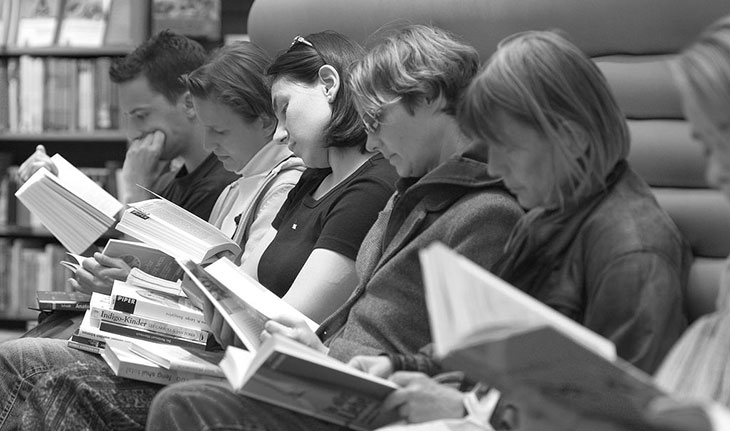'Picturing' Words Makes Faster Readers

schani via flickr | http://bit.ly/1FFHF1V
(Inside Science) – "Agua" is water, "pan" is bread, "cerveza" is beer. Exams are done and bags packed for spring break, but vacationing students (and snowbirds, too) are still likely to be reading new words as they travel to clear skies and sunny beaches. As a word is read, it grows increasingly familiar. Eventually, a part of the reader's brain turns the now-familiar string of letters and syllables into a pattern.
Rather than process each letter separately, our brains store the spelling of a familiar word as an image or pattern, according to the results of a study published this week in the Journal of Neuroscience.
The study supports the idea that when we learn a new word visually – by reading it rather than hearing it spoken aloud – a small part of the brain, located behind the left ear, creates a mental image of the word. Instead of remembering it as a string of letters or syllables, this region, called the visual word form area, gets trained to recognize the entire word as a pattern, forming a "visual dictionary" of our vocabulary. Representing written words in this way helps us recognize them more easily – and read faster.
"We know that in efficient readers this visual word form area is the area that seems to change the most as we learn to read," said study author Max Riesenhuber, a neuroscientist at Georgetown University Medical Center in Washington D.C.
Many previous studies have shown that reading alters the activity of neurons in the visual word form region. But precisely how it processes new words was unclear: some studies showed increased brain activity, others reported decreases or no changes to activity.
To clarify how words get added to this visual dictionary, Riesenhuber and his colleagues watched adult brains as they learned made-up three- and six-letter words. Unlike a word such as “apple,” these words – examples include “poat” and “joat” – lack any meaning. As a result, the participants’ brains were unlikely to connect such terms to images, sounds, or other context.
"So if the neurons respond differently it would not be due to differences in the meaning of the word, but because of the visual dissimilarities between the words," said Riesenhuber.
Participants in the study read and familiarized themselves with short pseudo-words, and were then tested for their ability to distinguish the fake words they had seen from ones that they had not read. Then, the researchers watched changes in blood flow and oxygenation of the visual word form area as the participants read different sets of fake words: one that they were familiar with, one that differed from the familiar pseudo-words by a few letters, and another that shared no letter with the familiar pseudo-words.
After learning a fake word, when participants read that word and a version with a few letters different, their brain activity suggested that different sets of neurons within the visual word from area were being used to recognize the two words. The difference was highest when the two paired words shared no letters at all. This suggested that each tiny brain region – or group of cells – was trained to identify one pattern of letters. Unfamiliar fake words did not evoke this response, suggesting that the readers' brains had not turned these strings of letters into "patterns" in their visual dictionaries.
"The study uses a small sample but has some pretty strong findings," said cognitive neuroscientist Elizabeth Norton of MIT who was not involved with the work. "It gives us new insight into what’s happening when we learn new words."
The visual word form area in many adults' brains lies directly across from a region on the right that recollects faces in a similar way: as pictures, rather than an assembly of eyes and noses. It may be differently placed in left-handed individuals or in children, Riesenhuber explained. But in previous studies, he and his coworkers have found that the neurons in this region function to learn words as visual patterns.
The current study only used words up to six letters long. Longer words that might require eye movements to be read through may not be stored as patterns, according to Riesenhuber.
"If you have a word like 'supercalifragilistic…' – we don't take it in as one chunk, just by virtue of its size," he said. "I think that one might be pushing it. But we haven't gone that far yet."
In future studies, the researchers plan to test how this process might change if pseudo-words are also ascribed meanings, similar to real words. Understanding how the visual word form area changes as new words – whether real or fake – are learned could help people with reading disabilities such as dyslexia.
"In reading impairment, people often have trouble forming the association between letters and sounds, and that's how reading is normally taught," said Riesenhuber. "Our paper shows that you can have this visual route to reading [instead], so we learn words as a visual pattern rather than sounding it out."
Jyoti Madhusoodanan is a science writer based in San Jose, California She tweets at @smjyoti
